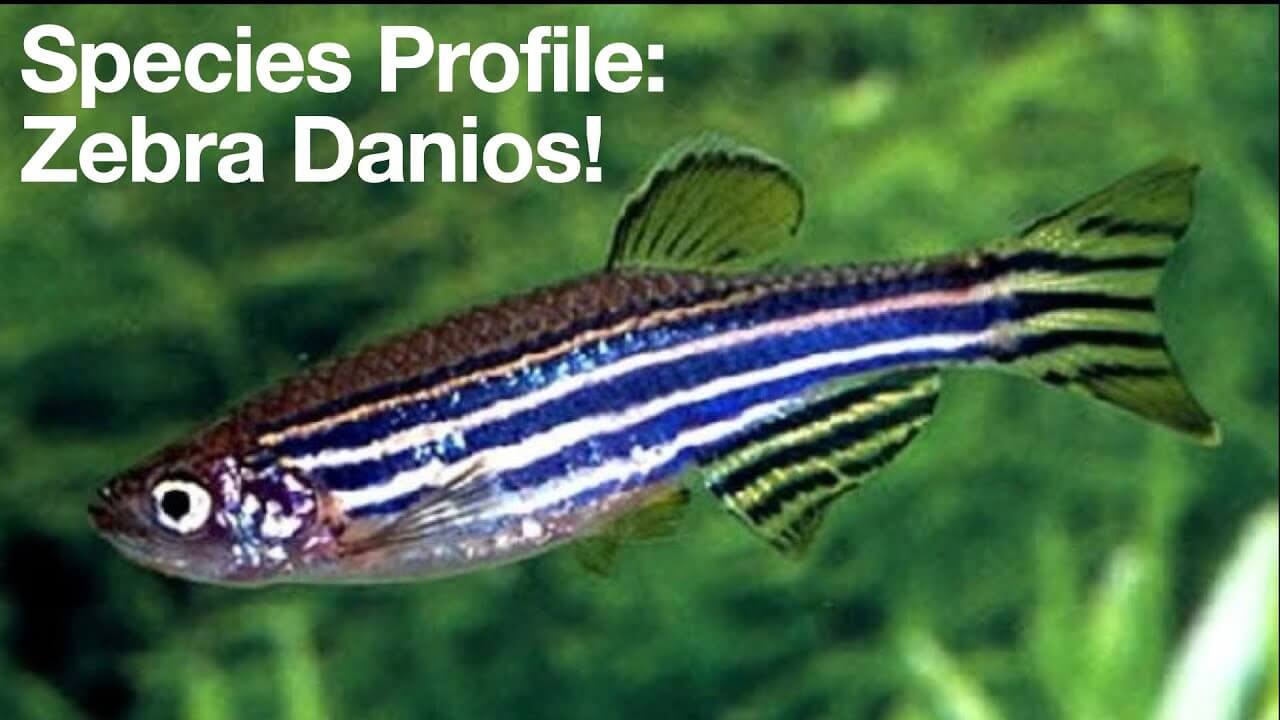Zebra Danios (Danio rerio) are among the most popular and recognizable fish in the freshwater aquarium hobby. These small but vibrant fish bring life and movement to any aquarium with their distinctive horizontal stripes and energetic swimming behaviour.
Native to the streams and waterways of South Asia, Zebra Danios have adapted well to life in captivity, making them a favourite among both novice and experienced aquarists.
The appeal of Zebra Danios extends beyond their striking appearance. Their hardy nature and adaptability to various water conditions make them an excellent choice for those new to fishkeeping. They thrive across multiple tank setups, from the minimalist to the heavily planted, and their peaceful demeanour allows them to fit seamlessly into community aquariums.
Key Takeaways for Zebra Danios
- Social and Active: Zebra Danios are highly social and active swimmers that thrive in groups, making them excellent for community tanks.
- Hardy and Easy to Care For: They are known for their hardiness and are considered easy to care for, making them ideal for beginners.
- Breeding: Zebra Danios are relatively easy to breed, with distinct breeding behaviours and requirements that can be managed in a home aquarium.
- Tank Conditions: They prefer a well-planted aquarium with space to swim and stable water conditions, with a preference for cooler temperatures than many tropical fish.
- Compatibility: Their peaceful nature makes them compatible with other peaceful fish, making them versatile inhabitants of community tanks.
Introduction
In addition to their aesthetic and community-friendly attributes, Zebra Danios play a significant role in scientific research, particularly genetics and developmental biology.
Their transparent embryos allow scientists to observe developmental processes in real time, contributing valuable insights into vertebrate biology and human diseases. This unique aspect further elevates their status beyond the home aquarium, highlighting their importance in recreational and scientific communities.
Furthermore, Zebra Danios are ideal for beginners to learn about the fundamentals of fish care, breeding, and aquatic ecosystem management.
Their breeding behaviour, in particular, offers a fascinating glimpse into the reproductive strategies of fish, providing an educational experience for hobbyists of all ages.
In freshwater aquariums, Zebra Danios are inhabitants and contributors to the ecosystem’s balance. They help control algae and detritus, promoting a cleaner and healthier environment for all tank inhabitants. Their active swimming patterns can encourage more timid species to venture out, creating a more dynamic and interactive aquarium.
The Zebra Danio’s combination of beauty, hardiness, and compatibility makes it a cornerstone species in the freshwater aquarium hobby.
Whether setting up your first tank or looking to add to a diverse community, Zebra Danios offer a blend of visual appeal, ease of care, and ecological utility that is hard to match.
Scientific and Common Names
The Zebra Danio, scientifically known as Danio rerio, is a small freshwater fish that has captivated the hearts of aquarium enthusiasts worldwide. The name “Danio” originates from the Bengali name “dhani,” meaning “of the rice field,” which reflects the fish’s natural habitat in the rice fields of South Asia.
The species name “rerio” is believed to be derived from a local indigenous term, although its exact origin is somewhat unclear. Together, Danio rerio translates to a fish of the rice fields, highlighting its natural environment and cultural significance in its native region.
| Characteristic | Description |
|---|---|
| Scientific Name | Danio rerio |
| Common Names | Zebra Danio, Zebrafish |
| Origin | South Asia |
| Family | Cyprinidae |
| Social | Very social and best kept in groups |
| Domain in Tank | Middle to top layer swimmer |
| Minimum Tank Size | 10 gallons (38 liters) |
| Diet | Omnivorous – enjoys flake, live, and frozen foods |
| Breeding | Egg scatterer, relatively easy to breed in captivity |
| Care Level | Easy |
| pH Range | 6.5 – 7.5 |
| Water Hardness | 5-12 dGH |
| Temperature | 64-75°F (18-24°C) |
| Common Diseases | Ich, fin rot (less common with proper care) |
| Life Span | 3-5 years |
| Size | Up to 2 inches (5 cm) |
| Best Tank Mates | Tetras, Corydoras, Guppies, other Danios, and peaceful community tank species |
Common Names: The Zebra Danio is aptly named for its distinctive horizontal stripes that run along the length of its body, reminiscent of a zebra’s stripes.
These stripes are a defining characteristic of the species and serve as an excellent camouflage mechanism in the wild, helping them blend into their surroundings to evade predators. The common name “Zebra Danio” is widely recognized in the aquarium trade and among hobbyists for its vivid patterning and dynamic swimming behaviour.
In addition to “Zebra Danio,” this species is sometimes called the “Zebrafish” in scientific and research contexts. The Zebrafish has become a prominent model organism in biological research due to its genetic, physiological, and behavioural similarities to humans and its transparent embryos, allowing for easy observation of developmental processes.
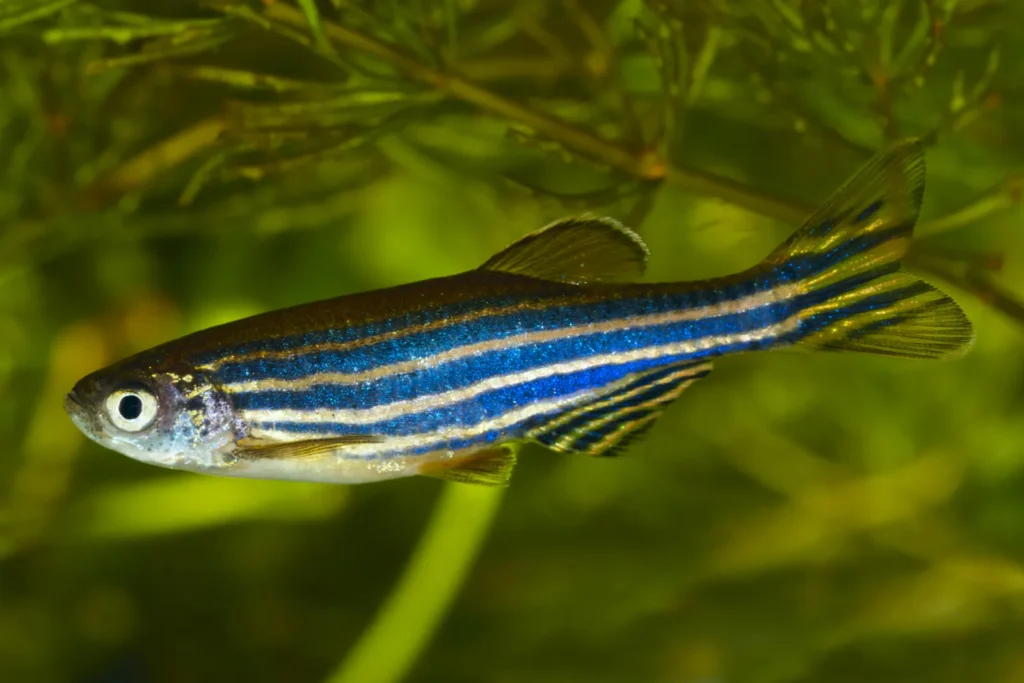
This dual identity as both a beloved aquarium pet and an essential research subject underscores the versatility and importance of Danio rerio beyond its aesthetic appeal.
The Zebra Danio’s adaptability to various water conditions, its peaceful nature and striking appearance, has made it a staple in community tanks and a favourite among novice and experienced aquarists.
Its scientific and common names reflect its physical attributes and natural habitat and its significance in both the hobbyist and scientific communities, making the Zebra Danio a fascinating subject of study and observation in the aquatic world.
Natural Habitat and Origin
Zebra Danios (Danio rerio) hail from South Asia’s diverse and flowing freshwater systems, including countries like India, Nepal, Bangladesh, and Myanmar.
Their natural habitat encompasses a range of aquatic environments, from slow-moving streams and rice paddies to fast-flowing rivers. These environments are characterized by clear to slightly turbid water, abundant vegetation, and a gravel, sand, or mud substrate, providing ample hiding spots and breeding grounds for these fish.
Adapted to such varied conditions, Zebra Danios are remarkably hardy and versatile. Their streamlined body enables efficient swimming in gentle and swift currents, allowing them to forage for food across different water flows.
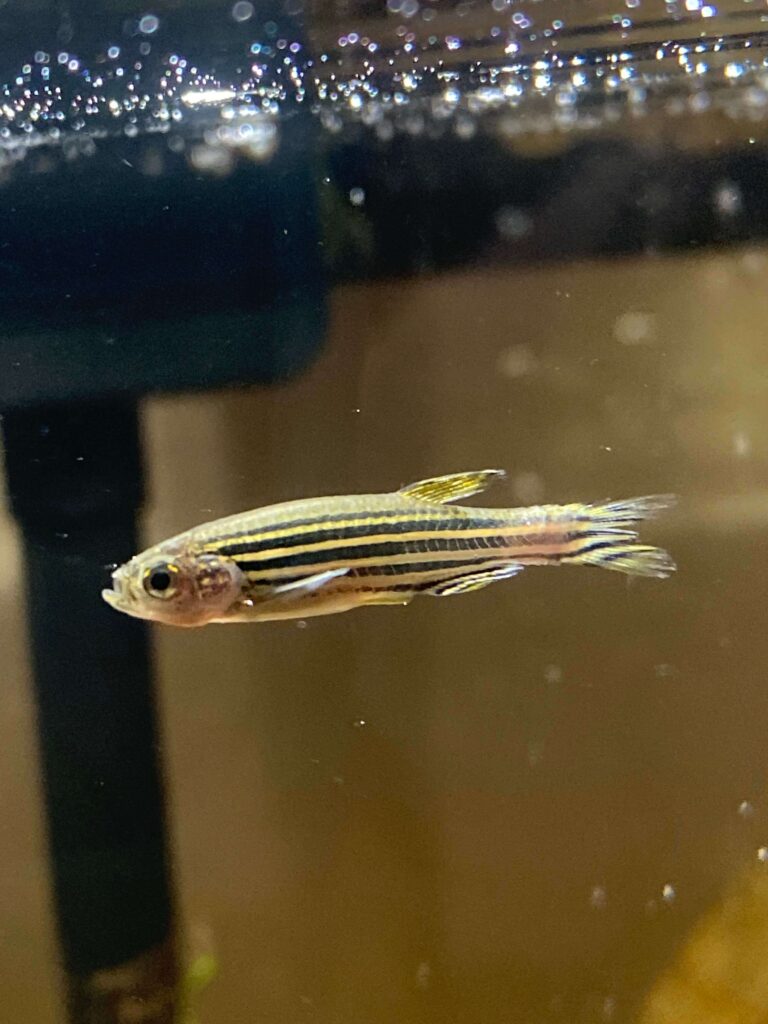
Their vibrant horizontal stripes effectively camouflage among aquatic plants and in the dappled sunlight of their natural habitat, protecting them from predators. This striping also plays a crucial role in social interactions and mating rituals within their species.
Furthermore, Zebra Danios have developed a wide tolerance for temperature, ranging from 64 to 75°F (18 to 24°C), which reflects the seasonal variations in their native environments.
This adaptability makes them resilient to changes in water conditions, contributing to their popularity in the aquarium hobby. Their omnivorous diet, consisting of small insects, crustaceans, and plant matter, further exemplifies their ability to thrive in diverse habitats by utilizing various food sources available in their ecosystem.
Physical Characteristics
Zebra Danios (Danio rerio) are small yet strikingly vibrant fish renowned for their dynamic swimming and distinctive appearance. Typically, they reach up to 2 inches (5 cm) in length, making them a perfect fit for community tanks. Their bodies are slender and torpedo-shaped, designed for agility and speed in the water.
The most captivating aspect of Zebra Danios is their colouration and patterns. Their name derives from the bold, horizontal stripes running along their bodies, reminiscent of a zebra’s markings.
These stripes are usually a deep blue to black, contrasting sharply against a silver or gold-hued background, which can shimmer beautifully under aquarium lighting.
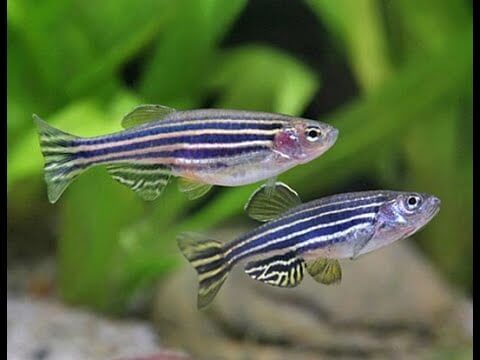
In addition to their stripes, Zebra Danios may exhibit a range of colour variations, including albino, golden, and leopard, the latter of which features a spotted pattern rather than stripes. Despite these variations, the classic striped pattern is the most common and sought-after among aquarists.
Gender differences in Zebra Danios are subtle but noticeable to the keen observer. Males are generally more slender and vibrant in colour, with more pronounced striping than their female counterparts. Conversely, females tend to have a rounder body, especially when gravid (carrying eggs), and their colouration may be slightly more subdued.
These differences become more apparent during the breeding season, as females display a fuller abdomen when ready to spawn.
Zebra Danios’ physical characteristics contribute to their popularity in the aquarium hobby and make them a fascinating subject for observation, adding a dynamic and visually appealing element to any freshwater setup.
Behaviour and Social Structure
Zebra Danios (Danio rerio) are renowned for their lively social behaviour and strong schooling nature, making them a dynamic addition to any freshwater aquarium. In the wild, these fish form large groups, a behaviour that is also observed in captivity.
They thrive in groups of six or more, as the presence of fellow Danios provides them with a sense of security and stimulates their natural schooling instinct. This social structure is crucial for their well-being, reducing stress and preventing aggressive behaviour often seen in solitary or paired fish.
The schooling nature of Zebra Danios is not just for safety; it also plays a significant role in their daily activity. These fish are known for their high energy levels, often seen darting across the tank coordinatedly.
Their activity is spread throughout the tank, but they predominantly occupy the middle to upper sections, where they can be seen swimming swiftly in an elegant display of agility and speed.
This preference for the tank’s upper domains makes them an excellent choice for adding movement and life to the upper levels of an aquarium, which are often less occupied by other species.
Zebra Danios’ adaptability to various water conditions and their peaceful nature make them compatible with many other species. However, their active swimming patterns and need for schooling should be considered when planning tank mates and aquarium size.
A well-planned aquarium that accommodates their social and active lifestyle ensures the health and happiness of Zebra Danios and creates a vibrant and engaging aquatic environment for enthusiasts to enjoy.
Aquarium Requirements
Minimum Tank Size and Setup Recommendations
Zebra Danios are active swimmers who thrive in tanks that allow ample space to move. A minimum of 10 gallons is recommended for a small group. Still, larger tanks are beneficial, especially for keeping a school of six or more, which helps display their natural schooling behaviour.
The aquarium setup should include a secure lid, as Zebra Danios are known to jump. A combination of open swimming spaces and areas with dense vegetation mimics their natural habitat and supports their well-being.
Water Parameters
- pH: Zebra Danios are adaptable but prefer a pH range between 6.5 and 7.5.
- Water Hardness: They thrive in soft to moderately hard water, with a dGH between 5 and 12.
- Temperature: Cooler than many tropical fish, they do well in temperatures ranging from 64°F to 75°F (18°C to 24°C). This tolerance for lower temperatures makes them suitable for unheated tanks in warm climates.
Suitable Decorations and Plant Suggestions
Decorations and plants play a crucial role in replicating the natural environment of Zebra Danios. They appreciate the presence of driftwood, rocks, and caves as hiding spots. Live plants are highly recommended, not only for oxygenation but also for providing shelter and breeding grounds.
Hardy plants like Java Fern, Anubias, and Hornwort can withstand the cooler temperatures preferred by Zebra Danios and do not require intense lighting, making them ideal choices.
Floating plants can also be added to provide shade and additional hiding spots, creating a layered habitat that encourages exploration and natural behaviour.
Incorporating these elements into your aquarium setup will ensure your Zebra Danios have a stimulating and comfortable environment, closely mimicking their natural habitat and promoting healthy, active lives.
Diet and Nutrition
Overview of Dietary Needs
Zebra Danios are omnivorous, displaying a flexible diet that includes plant and animal matter. Their dietary habits in the wild consist of small insects, larvae, and algae, which should be mirrored in their aquarium diet to ensure they receive a balanced nutrition.
Types of Food
- Flake Foods: High-quality flake foods are a good staple for Zebra Danios, providing essential nutrients.
- Live Foods: To mimic their natural diet, offering live foods such as brine shrimp, daphnia, and bloodworms can encourage natural foraging behaviour and provide protein.
- Frozen Foods: Frozen varieties of the live foods mentioned are a convenient alternative, offering similar nutritional benefits.
- Vegetable Matter: Including spirulina flakes or blanched vegetables like zucchini and spinach can help fulfil their need for plant-based nutrients.
Feeding Schedule
Zebra Danios thrive on a regular feeding schedule. Feeding them in small amounts two to three times a day is ideal. This meets their nutritional needs and aligns with their active foraging nature.
Monitoring the amount of food consumed within a few minutes is crucial to avoid overfeeding and water quality issues that can arise from excess food decomposing in the tank.
Breeding Zebra Danios
Breeding Zebra Danios is a rewarding experience that can be achieved with the right conditions and care. Here’s how to encourage spawning and care for the fry.
Breeding Conditions
To encourage Zebra Danios to breed, mimic their natural spawning conditions. Start by setting up a separate breeding tank with a water temperature slightly higher than their regular tank, around 78°F (25.5°C).
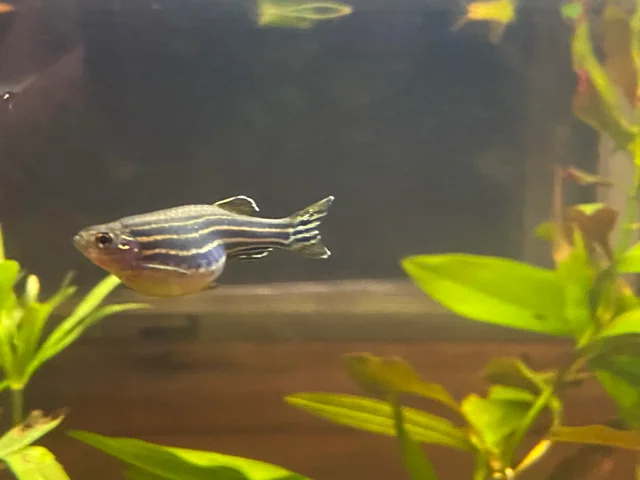
The tank should be shallow, with a water depth of about 6 inches (15 cm), and equipped with a spawning substrate like marbles or a mesh screen to protect the eggs from being eaten. Soft, slightly acidic water with a pH around 6.5-7.0 is ideal. Provide plenty of plants or spawning mops for egg deposition.
Encouraging Spawning
Condition the breeding pair with high-quality live or frozen foods, such as brine shrimp or daphnia, to stimulate spawning. Zebra Danios typically spawn in the early morning.
Dim lighting or the natural light cycle can also encourage spawning behaviour. Once you notice eggs being scattered, removing the adult Danios is crucial to prevent them from eating them.
Egg Scattering Behavior
Zebra Danios are prolific breeders and exhibit egg-scattering behaviour. The female releases eggs while the male fertilizes them externally. They do not exhibit parental care; hence, the eggs are left to develop independently. The eggs will hatch in 2-3 days, depending on the temperature.
Fry Care
Once hatched, the fry will feed on their yolk sac for several days. After absorbing the yolk, feed them with infusoria or commercially available liquid fry food until they are large enough to eat crushed flake or baby brine shrimp. Regular water changes and stable water conditions are crucial for the growth and health of the fry.
Breeding Zebra Danios can be straightforward and enjoyable by providing the right conditions and diligent care.
Health and Common Diseases
Common Health Issues and Prevention
Zebra Danios are known for their hardiness, but like all aquarium fish, they are susceptible to specific health issues. The most common ailments include Ichthyophthirius multifiliis (Ich), a parasitic disease manifesting as white spots on the body and fins, and fin rot, a bacterial infection that causes the fins to fray and decay.
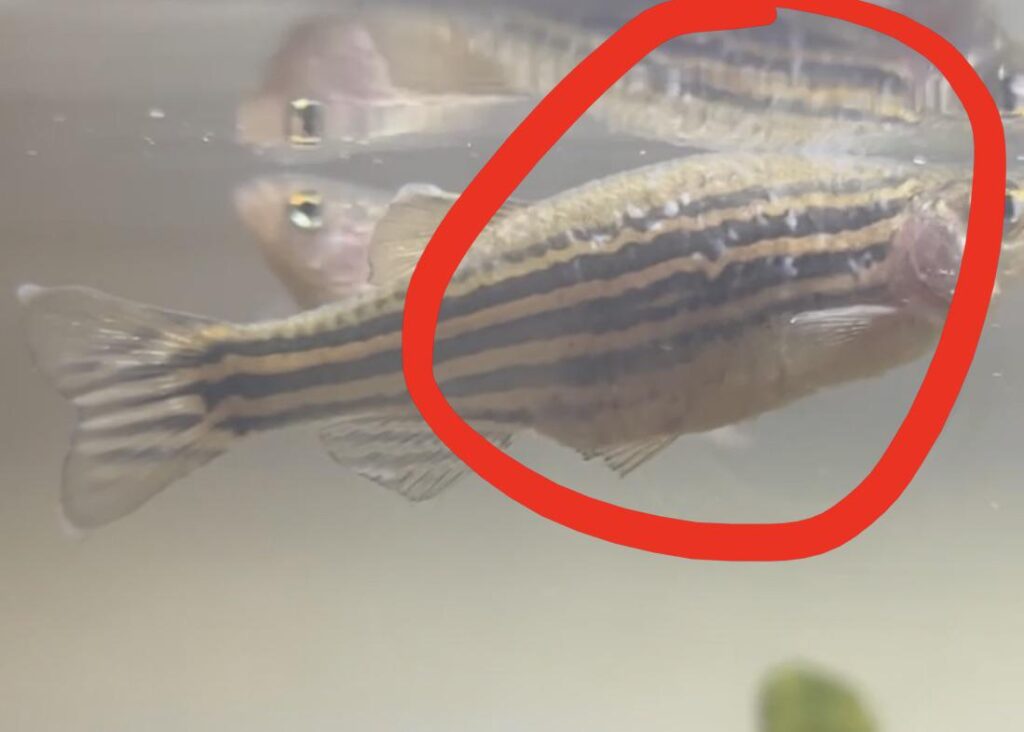
Preventing these diseases starts with maintaining high water quality. Regular water changes, at least 20-30% every two weeks, and monitoring water parameters (pH, temperature, ammonia, nitrites, and nitrates) are crucial. Overcrowding should be avoided as it can lead to stress and lower immunity, making fish more susceptible to diseases.
Tips for Maintaining Optimal Health
- Quarantine New Arrivals: Always quarantine new fish for at least 2-3 weeks before introducing them to your main tank to prevent the spread of diseases.
- Balanced Diet: Feed a varied diet of high-quality flakes, pellets, and occasional live or frozen foods to ensure they receive all necessary nutrients.
- Stress Reduction: Provide plenty of hiding spots and maintain a stable social group to minimize stress. Stress is a significant factor in lowering immune response.
- Regular Observation: Keep a close eye on your fish for any signs of abnormal behaviour or appearance. Early detection of health issues is vital to successful treatment.
- Proper Acclimation: When introducing Zebra Danios to a new tank, ensure they are properly acclimated to the water conditions to reduce shock.
Following these guidelines, you can help ensure your Zebra Danios remain healthy and vibrant, enjoying a long life in your aquarium. Regular care and attention are the best defences against common diseases and are essential for maintaining a thriving aquatic environment.
Compatibility with Other Fish
Zebra Danios are known for their peaceful demeanour and active swimming habits, making them excellent candidates for community tanks. However, selecting suitable tank mates is crucial to maintain harmony and ensure the well-being of all inhabitants.
Best Tank Mates for a Harmonious Aquarium
- Tetras: Small and peaceful, Tetras share similar water requirements and are not aggressive towards Danios.
- Corydoras Catfish: Bottom dwellers that complement the top and mid-water swimming Danios. Corydoras are peaceful and help keep the tank clean.
- Guppies: Their peaceful nature and vibrant colours make Guppies ideal companions for Zebra Danios in a community tank.
- Other Danios: Mixing different species of Danios can create a lively and visually appealing setup without increasing aggression.
- Mollies and Platies: These are hardy fish that can adapt to various water conditions, making them suitable companions for Zebra Danios.
Species to Avoid
- Large Cichlids: Aggressive and territorial, large Cichlids can bully or even harm smaller, peaceful fish like Zebra Danios.
- Bettas: The slow-moving and long-finned nature of Bettas can be stressed by Danios’s active swimming, and Bettas may become aggressive.
- Goldfish: While peaceful, Goldfish require different water temperatures and tend to produce a lot of waste, which can lead to poor water quality for Danios.
In summary, when choosing tank mates for Zebra Danios, opt for species that share similar water requirements and have a peaceful temperament. Avoid aggressive or territorial fish that could stress or harm your Danios. Zebra Danios can thrive and add vibrancy and activity to your community aquarium with suitable companions.
Care Level and Maintenance
Zebra Danios are renowned for their hardiness and ease of care, making them an excellent choice for novice and experienced aquarists. Proper maintenance routines are crucial for keeping these active fish healthy and their environment stable. Here’s a breakdown of the care and maintenance schedule:
Daily Care Checklist:
- Feedings: Offer small amounts of food twice a day. Zebra Danios thrive on a varied diet of flake food, frozen, or live foods such as brine shrimp and daphnia.
- Observation: Spend time watching your fish for any signs of stress or illness, such as changes in eating habits or appearance.
Weekly Care Checklist:
- Water Testing: Check the aquarium’s water parameters (pH, ammonia, nitrite, and nitrate levels) using a water testing kit. Zebra Danios prefer a pH between 6.5 and 7.5 and require stable water conditions.
- Partial Water Change: Perform a 10-15% water change to remove toxins and replenish essential minerals. This helps in maintaining a clean and healthy environment.
Monthly Care Checklist:
- Filter Maintenance: Clean or replace the filter media to ensure efficient operation. Avoid cleaning all media at once to preserve beneficial bacteria.
- Tank Cleaning: Gently vacuum the substrate to remove detritus and uneaten food. Clean the aquarium glass, decorations, and plants to prevent algae buildup.
Water Change Frequency and Tank Cleaning Tips:
- Regular Water Changes: A consistent schedule of 10-15% weekly water changes is recommended to keep water quality high.
- Algae Control: Introduce algae-eating species or manually remove algae to prevent excessive growth. Ensure the tank receives moderate light to control algae proliferation.
- Equipment Maintenance: Regularly check and maintain aquarium equipment, including heaters and filters, to ensure they function correctly.
Summary
The Essence of Knowledge: Zebra Danios (Danio rerio) are not just another fish in the aquarium; they are a testament to the beauty and complexity of aquatic life. Understanding their needs—from the specific water parameters they thrive in to their social behaviour and dietary requirements—is crucial for their well-being.
This knowledge ensures that these active and hardy fish lead healthy, vibrant lives in your aquarium. By recognizing the importance of their natural habitat, behaviour, and care requirements, hobbyists can replicate a conducive environment that mirrors their wild ecosystems closely.
Tailored Care: Each aspect of Zebra Danio care, from tank setup and water quality to diet, plays a significant role in their health and longevity. Their preference for cooler water, ample swimming space, and omnivorous diet are not just facts but essential care components that contribute to their overall well-being.
By adhering to these care specifics, enthusiasts can prevent common diseases and ensure their Danios exhibit their natural, lively behaviour and striking colours.
Encouragement for Responsible Fishkeeping
A Commitment to Life: Keeping Zebra Danios goes beyond the joy and beauty they bring to our homes; it’s a commitment to sustaining a miniature ecosystem.
Responsible fishkeeping means recognizing these creatures’ long-term commitment, including regular maintenance, monitoring water conditions, and providing a balanced diet.
Conservation and Education: By maintaining healthy aquariums for species like the Zebra Danio, hobbyists contribute to the broader goals of aquatic preservation and education.
Sharing knowledge and experiences with the community can inspire responsible practices among fellow enthusiasts, fostering a culture of care and respect for aquatic life.
Successful care for Zebra Danios hinges on understanding and meeting their specific needs. This journey of responsible fishkeeping enhances the lives of these fascinating fish and enriches the hobbyist’s experience, promoting a sustainable and ethical approach to the aquarium hobby.

